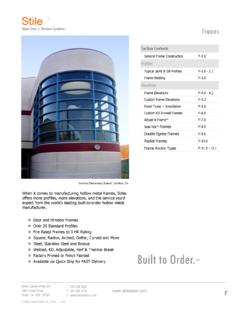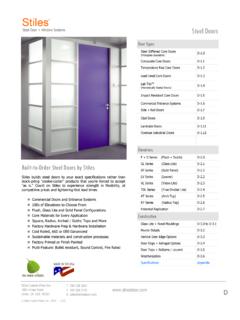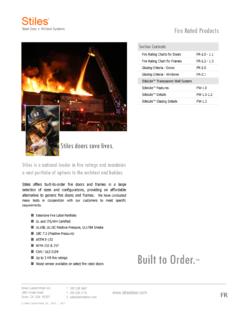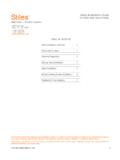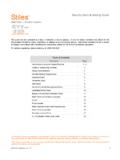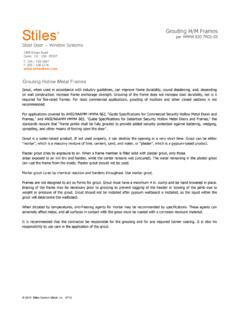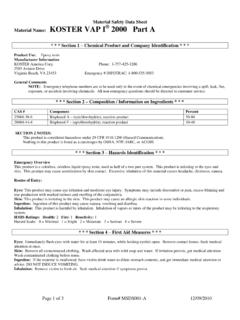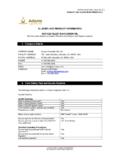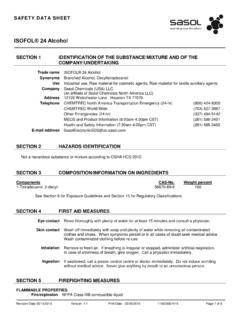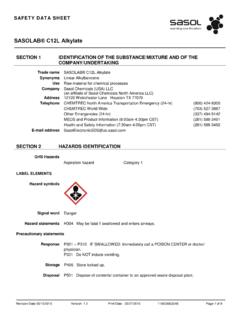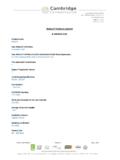Transcription of Tnemec Company, Inc. For coatings, resins and …
1 Tnemec Company, West 23rd Avenue, Kansas City, MO 64116-3064 Emergency Telephone: 800-535-5053 (INFOTRAC)Telephone: 816-474-3400 material Safety Data Sheet (MSDS)For coatings, resins and related materials, approved by the Department of Labor as essentially similar to form OSHA-20, meets requirements of CFR 29 Part , OSHA'S hazard communication standard. NPCA 1-84 PREPARED DATE:07/17/2003 Series:1075-11 WHAACRYLICP roduct Class:SERIES 1075 ENDURA-SHIELD IIPage 1 of 2 SECTION 2 - HAZARDOUS INGREDIENTSPEL - CPEL -TWATLV - CTLV - STELTLV - TWAOSHAACGIHOCCUPATIONAL EXPOSURE @ 68% By #INGREDIENTSoFPEL - STEL1344-28-1 1-5 ALUMINUM MG/M3123-86-4 PPM7631-86-9 1-5 AMORPHOUS MG/M37631-86-9 1-5 AMORPHOUS MG/M313463-67-7 21-30 TITANIUM DIOXIDE (TOTAL DUST) MG/M314808-60-7 SILICA (QUARTZ) MG/M3110-43-0 N-AMYL PPMThis product contains one or more reported carcinogens or suspected carcinogens which are noted NTP, IARC, or OSHA-Z in the other limits recommended column.
2 This product contains pigment dusts which may be released when subjected to abrasive blasting, sanding, or grinding.** SARA Reportable ProductSECTION 3 - HEALTH HAZARD INFORMATIONEMERGENCY OVERVIEW: POTENTIAL HEALTH EFFECTS: EYE: Redness, tearing, blurred vision. Severe irritation. SKIN: Moderate irritation, drying of skin, defatting and possible dermatitis. INHALATION - OVEREXPOSURE TO SOLVENT VAPORS OR SPRAY MIST: Nasal and respiratory irritation, anesthetic effects, dizziness, possible unconsciousness and asphyxiation, stupor, weakness, fatigue, nausea, and headache. INHALATION - OVEREXPOSURE TO FREE PIGMENT DUST: Coughing, wheezing, shortness of breath, restricted nasal passages, lung injury. INGESTION: Gastrointestinal irritation, nausea, vomiting, diarrhea, death, aspiration into the lungs which can be fatal. CHRONIC EFFECTS: Prolonged inhalation of dusts containing crystalline silica may result in the development of a lung disease known as silicosis.
3 NOTICE: Reports have associated repeated and prolonged occupational overexposure to solvents with permanent brain and nervous system damage. Intentional misuse by deliberately concentrating and inhaling the vapors may be harmful or fatal. This product contains crystalline silica, which is considered a cancer hazard by inhalation of respirable dust. The Internation Agency for Research on Cancer (IARC) concluded that respirable crystalline silica inhaled in the form of quartz or cristobalite from occupational sources is carcinogenic to humans (Group 1B). TARGET ORGANS: Can cause respiratory tract irritation. Can cause skin irritation. Can cause lung damage. Can cause eye irritation. Can cause gastrointestinal tract irritation. Can cause nervous system effects. Can cause cancer. Risk of cancer depends on duration and level of exposure. Can cause liver damage. OTHER: This product when mixed with other components acquires the hazards of all components.
4 PRIMARY ROUTES OF ENTRY: Dermal and Inhalation. PROPOSITION 65: Pigments and/or other raw materials present in this product contain trace amounts of a chemical or chemicals known to the State of California to cause cancer, birth defects or other reproductive 4 - FIRST AID MEASURESEYE CONTACT: Flush immediately with large amounts of clean water under low pressure for at least 15 minutes. Consult a physician. SKIN CONTACT: Wash affected area with soap and water. Remove contaminated clothing. Dispose of or launder accordingly. Consult a physician if skin irritation persists. INHALATION: Remove affected individual to fresh air. Treat symptomatically. If breathing is difficult, administer oxygen. If breathing has stopped give artificial respiration. Consult a physician. INGESTION: Drink 1 or 2 glasses of water to dilute. Do not induce vomiting. Consult a physician or poison control center IMMEDIATELY.
5 Treat symptomatically. NOTE TO PHYSICIAN:PREPARED DATE:07/17/2003 Series:1075-11 WHAACRYLICP roduct Class:SERIES 1075 ENDURA-SHIELD IIPage 2 of 2 SECTION 5 - FIRE AND EXPLOSION HAZARD DATA FLAMMABILITY CLASSIFICATIONEXPLOSION LEVEL LOWFLAMMABILITY LIMITS LOWEREXPLOSION LEVEL HIGHFLASHPOINTFLAMMABILITY LIMITS MEDIA: Foam, carbon dioxide, and dry chemical. FIRE-FIGHTING PROCEDURES AND EQUIPMENTS: Keep away from heat, open flames, sparks, and areas where static charge may be generated. Do not apply to hot surfaces due to possible fire and explosion risk. For closed containers, pressure build-up and possible explosion might occur due to extreme heat exposure. Solvent vapors are heavier than air and may travel considerable distance to a source of ignition and flash back. Water may be used to cool unruptured containers. Wear self-contain- ed breathing apparatus with a full facepiece operated in pressure- demand or other positive pressure mode to prevent inhalation of hazardous decomposition products.
6 Use appropriate extinguishing media to control fire. Water may cause violent frothing if sprayed directly into containers of burning 6 - SPILL OR LEAK PROCEDURESCLEAN-UP: Remove all sources of ignition. Spills may be collected with inert, absorbent material for proper disposal. Use non-sparking tools, protective gloves, goggles and clothing, adequate ventilation, avoid the breathing of vapors and use respiratory protective devices. Transfer absorbent material to suitable containers for proper disposal. Remove containers to a safe place and cover loosely until carbon dioxide has finished 7 - SPECIAL PRECAUTIONSHANDLING AND STORAGE: Store in dry area. Keep closures tight and upright to prevent leakage. Do not store in high temperature areas or near fire or open flame. Refer to product data sheet for recommended storage temperatures. SPECIAL COMMENTS: Prevent prolonged breathing of airborne contaminants such as vapor, spray mists, or dusts.
7 Prevent contact with skin and eyes. Do not take internally. Keep out of reach of children. Do not reuse or alter containers without proper industrial cleaning. Do not weld or flame cut empty, uncleaned containers due to potential fire and explosion hazard. Consult product data sheet for proper application 8 - SAFE HANDLING AND USE INFORMATIONHYGIENIC PRACTICES: Wash hands and other contaminated skin areas with warm soap and water before eating. EYE PROTECTION: Use chemical resistant splash type goggles. RESPIRATORY PROTECTION: Respiratory protective devices must be used when engineering and administration controls are not adequate to maintain Threshold Limit Values (TLV) and Permissible Exposure Limits (PEL) of airborne contaminants below the listed values for those hazardous ingredients identified in Section II of this MSDS. Observe OSHA regulations for respirator use (CFR 29, ) whenever a respirator is used.
8 Particulate, chemical cartridge, air purifying half-mask respirators can be used within certain limitations; consult the respirator manufacturer for specific uses and limitations. Where airborne contaminant concentrations are unknown, the use of a NIOSH/MSHA approved fresh-air supplied respirator is mandatory. OTHER PROTECTION: Use Chemical resistant gloves. Use chemical resistant coveralls or apron to protect against skin and clothing contamination. Use protective cream where skin contact is likely. VENTILATION: Sufficient ventilation, in volume and pattern, should be provided through both local and general exhaust to keep the air contaminant concentration below current applicable OSHA Permissible Exposure Limits (PEL) and ACGIH's Threshold Limit Values (TLV). Appropriate ventilation should be employed to remove hazardous decomposition products formed during welding or flame cutting operations of surfaces coated with this product.
9 Heavier than air solvent vapors should be removed from lower levels of work area due to potential explosion hazard and all ignition sources (non-explosion proof equipment) should be eliminated if flammable mixtures will be 9 - PHYSICAL AND CHEMICAL PROPERTIESVAPOR DENSITYLOWERBOILING RANGEFORMULA WEIGHTBY VOLUMEVOC IN LBS PERGALLONEVAPORATIONRATE%VOLATILE BYWEIGHT- LB/GLHIGHERBOILING (Ether = 1) 10 - STABILITY AND REACTIVITYINCOMPATIBILITIES: Strong oxidizing agents. Caustics. DECOMPOSITION: Carbon monoxide, carbon dioxide, hydrocarbon fragments CONDITIONS TO AVOID: Heat, sparks, open flames. POLYMERIZATION: Will not occur. STABILITY: 13 - DISPOSAL CONSIDERATIONSWASTE DISPOSAL: Dispose of in accordance with Federal, state, and local regulations regarding 16 - HMIS INFORMATIONH ealth: 3 Flammability: 3 Reactivity: 1 This is a condensed MSDS, providing safety and health information pertinent to the complete product series.
10 Physical constants such as , VOC content and chemical constituents will vary with color. Safety and health information may also vary with color. Certain colors may contain Carbon Black and Crystalline Silica, which have been identified as reported or suspected carcinogens. Prolonged inhalation of respirable dusts containing Crystalline Silica may result in the development of a lung disease known as silicosis. For a complete, color-specific MSDS, please contact your local Tnemec representative listed at specific information regarding occupational safety and health standards, please refer to the Code of Federal Regulations, Title 29, Part 1910. To the best of our knowledge, the information contained herein is accurate. However,neither the Tnemec Company or any of its subsidiaries assume any liability whatsoever for the accuracy of completeness of the information contained herein. Final determination of suitability of any material is the sole responsibility of the user.
